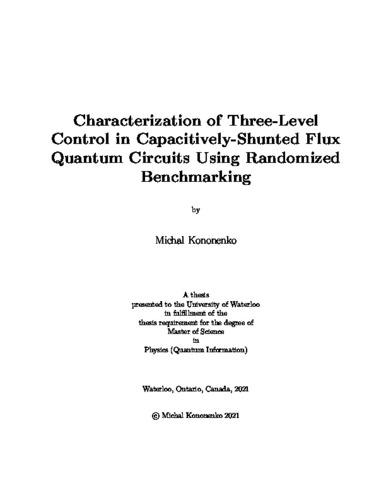| dc.contributor.author | Kononenko, Michal | |
| dc.date.accessioned | 2021-05-12 17:45:28 (GMT) | |
| dc.date.available | 2023-05-13 04:50:03 (GMT) | |
| dc.date.issued | 2021-05-12 | |
| dc.date.submitted | 2021-02-15 | |
| dc.identifier.uri | http://hdl.handle.net/10012/16977 | |
| dc.description.abstract | Superconducting devices have emerged as leading candidates for building practical quantum computers, owing to their scalability, designability, and ease of control. Development of superconducting devices has been accompanied by increases in coherence times from nanoseconds to tens of microseconds, and a multitude of new types of superconducting qubits. In turn, these improvements in coherence, and study of superconducting qubits has produced models for these devices accurate and trustworthy enough to enable design decisions to be determined prior to device fabrication. Recent work by the superconducting quantum devices (SQD) group has produced a variant of the capacitively-shunted flux qubit that features fast control over the lowest three levels, allowing the device to be used as a qutrit. This thesis presents a model and characterization results for this device.
This thesis also presents experimental results characterizing control fidelity for a qutrit using randomized benchmarking (RB). Quantum process tomography and application of repeated gate sequences are also used to support the randomized benchmarking results. The method of synthesizing the gates in the qutrit Clifford group can decompose any gate into two-state rotations. The fidelity of 99.0 +/- 0.2% obtained by randomized benchmarking establishes the device as a useful qutrit, and outlines interesting directions in using higher levels to improve qubit-based quantum computers, and in using higher levels to pack more states into fewer devices in quantum computers. Analysis of experimental results indicates errors are dominated by ac-Stark and Bloch-Siegert shifts during qutrit control.
This thesis then presents two new devices meant to study the impact of changing design parameters on the suitability of flux qubits for multilevel control. The first device test individual qubits, with the goal of further improving the coherence time, and improving qutrit control. The second device couples two devices together, so that two-qubit gates can be studied. The available design parameters and their impact on qubit properties are discussed, and design variations are selected for the single and two-qubit devices. The result is a set of devices ready for manufacture and experimental characterization. | en |
| dc.language.iso | en | en |
| dc.publisher | University of Waterloo | en |
| dc.title | Characterization of Three-Level Control in Capacitively-Shunted Flux Quantum Circuits Using Randomized Benchmarking | en |
| dc.type | Master Thesis | en |
| dc.pending | false | |
| uws-etd.degree.department | Physics and Astronomy | en |
| uws-etd.degree.discipline | Physics (Quantum Information) | en |
| uws-etd.degree.grantor | University of Waterloo | en |
| uws-etd.degree | Master of Science | en |
| uws-etd.embargo.terms | 2 years | en |
| uws.contributor.advisor | Lupascu, Adrian | |
| uws.contributor.affiliation1 | Faculty of Science | en |
| uws.published.city | Waterloo | en |
| uws.published.country | Canada | en |
| uws.published.province | Ontario | en |
| uws.typeOfResource | Text | en |
| uws.peerReviewStatus | Unreviewed | en |
| uws.scholarLevel | Graduate | en |

